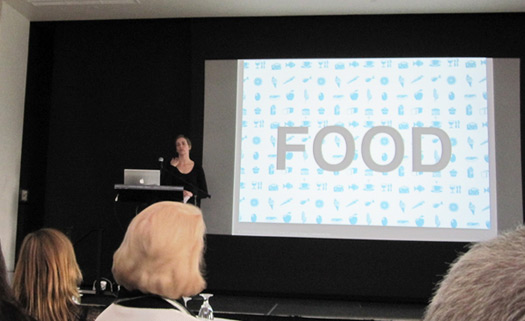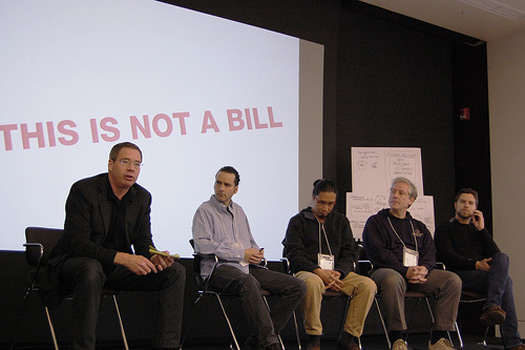
November 24, 2009
Aspen Design Summit Report: Sustainable Food and Childhood Obesity

Abstract
At the Aspen Design Summit sponsored by AIGA and Winterhouse Institute November 11–14, 2009, the Food Project set out to identify where design interventions might change the pace, degree or scale of transformations already underway in the national food system in order to counteract the childhood obesity epidemic.
The basic premise is that the U.S. food system is broken. While the industrialization of agriculture has made more food available more cheaply than ever before, it has come at great cost — from widespread soil erosion to environmental calamities, food safety issues and the obesity crisis, especially among young people. To tackle this expansive topic, the team leveraged the concept of “regionality” to create a more sustainable food production and delivery system. The goal would be to aid and accelerate the shift from a global, abstract food system to a regional, real food system via a robust portfolio of activities — including a grand challenge and a series of youth-engagement programs.
We Are Getting Larger
Two out of three Americans and one-third of American children are overweight or obese. Boys and girls in elementary school are suffering from unprecedented rates of high blood pressure and cholesterol, Type 2 diabetes and even gallstones, once a singularly adult affliction. Last year, the costs of treating obesity came to $147 billion. It’s clear: addressing and reversing these effects by supporting an emerging alternative, sustainable system of food production, distribution and consumption is one of the core challenges of our time.Â
The food system is, of course, intrinsically connected to childhood obesity. Two team members, Michael Conard (assistant director of the Urban Design Lab at Columbia University’s Earth Institute) and Ken Kaplan (associate director of Collaborative Initiatives group at MIT), who have spent the last few years charting the territory with a comprehensive study called Curbing Childhood Obesity: Searching for Comprehensive Solutions, offered up a critical perspective on the links between our broken food system and the childhood obesity epidemic.
They also noted that an entrenched system of intertwined commercial and government interests has helped get us to where we are today. Americans eat too much of the wrong food, which is made in ways that have disastrous consequences for our health, our environment, our economy and our future.
The good news is that we’re already broadly engaged in a fundamental rethinking of how we produce, process, distribute and consume food. Examples abound, from urban and vertical farming to small-scale sustainable farming methods, farm-to-table projects, NYC’s Green Carts, school lunch programs and new technologies. Consider the success of books by Michael Pollan, the Slow Food movement and Michelle Obama’s White House organic garden.Â
Incubating Change
The vehicle for this shift is an organizing entity the team named the Regional Food Incubator (RFI). While the precise operational model of the RFI (potentially a platform, a coalition of stakeholders, a coordinating non-profit, a governing body, etc.) has yet to come into focus, the team was clear on its purpose: to identify, coordinate, integrate and accelerate innovations and positive change toward a sustainable food system at the regional level.
To that end, the RFI would develop and offer an evolving set of capabilities and resources: including critical metrics (such as a visual index of progress toward healthy, sustainable communities), a system of galvanizing prizes, grants and fellowships, youth engagement initiatives, a dynamic archive of shared lessons and stories around best practices and lessons learned, a toolkit (including educational, vocational and entrepreneurial resources), funding mechanisms and messaging campaigns.
A Request-for-Proposal-based grand challenge would target a narrow group of pilot communities (rather than represent a sweeping nationwide project), thereby prototyping regional food sheds in a handful of communities. Called the “Regional Foodshed Challenge” (RFC), it would stage a national competition to identify, coordinate and accelerate the creation of sustainable food systems across the country. The rough design of the challenge would award $50 million to 5 regions that achieve a meaningful reduction (say 5 percent per year over 5 years) in childhood obesity levels.
The RFC would require communities or regions to pre-qualify by demonstrating a readiness to innovate and transform through such measures as levels of social capital, political will and deep-seated commitment to reform. The challenge would emphasize transformation over time rather than a quick fix. To that end, the prizes might be awarded in a staged fashion and offer up infrastructure for longitudinal research and economic development along with a large financial reward. For instance, challenge-winning regions might become pilot sites for a consortium of food and technology companies, agencies and researchers devoted to greater integration and sustainability of regional foodsheds.
At the same time, the RFI would work to widen the circle of positive change generated through the RFC process. A key role of the RFI here would be to continue to define and refine the core parameters and principles of a sustainable food system. Those include: “asset” mapping projects, robust metrics, youth engagement strategies and, always, the promotion of “conscious market creation,” because a sustainable food system is an inextricable element of a sustainable economy.
Youth Food Mapping Crew
It is also critical to engage the people at the heart of the crisis — young people. Way too many kids have no clue where their food comes from. But they do have a sense of curiosity and a facility with digital, mobile and social-media tools.
One idea is to launch a project to enlist a community (or multiple communities) of young people to map the sources, processes, places and experiences related to what, where and how they eat. This pilot project would provide not only a baseline against which to plot change, but would also engage kids in a meaningful conversation about good food and activate their participation in change via rich visualization, feedback loops and social-networking tools. Partnership opportunities abound — from the Girl Scouts to Think MTV as well as technology brands like Apple and Google.
Youth engagement strategies might involve the development of problem-solving and collaborative games aimed at advancing a sustainable food system (there are many models of this already at work, such as the Oracle-sponsored VisionQuest and the Games for Change portfolio of efforts). Another way to connect kids together in tackling big social challenges might involve school “twinning” or digital “pen-pal” programs.
Next Steps and Action Plan
Having conceived and outlined the RFI, RFC and youth strategy concepts, the team believes it’s necessary to further refine and test the proposals. This will require an iterative process of developing a more nuanced and detailed description of the RFI, and mapping the universe of sustainable food initiatives already underway (in addition to the youth mapping project). Moreover, it is important to widen the circle of participants at the table to include the vast, but as yet uncoordinated, new food initiatives. To accomplish this, team members are committed to holding two development sessions in the coming months: one on the West Coast to focus on the RFC program and another on the East Coast to look at youth strategies.
The Team
Anna Muoio (moderator), Principal, Social Innovation Practice, Continuum
Polly LaBarre (recorder), Writer and Consultant; Co-Author of Mavericks at Work
Marc Alt, Principal, Marc Alt + Partners; AIGA Center for Sustainable Design
Allison Arieff, Design Columnist, The New York Times; Content Strategist, Urban Revision
Valerie Casey, Founder, Designers Accord
Ted Chen, Director for Innovation and Learning, Kellogg Foundation
Michael Conard, Assistant Director, Urban Design Lab at The Earth Institute, Columbia University
Kathryn Johnson, Board Member, Friends of the UN World Food Programme
Ken Kaplan, Associate Director, Collaborative Initiatives, MIT
Steve McCallion, Executive Creative Director, Ziba Design
Rick Robinson, Research Fellow, Continuum
Inga Treitler, Terranova Group and National Association for the Practice of Anthropology
Jen van der Meer, Strategist and Activist; Chair, O2NYC
Significant contributions to the writing of this report were made by Polly LaBarre and Anna Muoio.
Documents
A PDF of the briefing book chapter on the CDC Healthy Aging Project is available here.
The original website for the Aspen Design Summit, as well as a list of all participants, is here.
Observed
View all
Observed
By Aspen Editors
Related Posts

Ernest Beck|Event-Aspen
Sustainable Health Enterprises Wins Prestigious Curry Stone Design Prize

Arts + Culture
Aspen Editors|Event-Aspen
Aspen Design Summit: Update 09.25.10

Helen Walters|Event-Aspen
Next: Innovation Tools & Trends Rockefeller Foundation’s Push Toward Design and Innovation

Helen Walters|Event-Aspen
Inside the Design Thinking Process
Recent Posts
Minefields and maternity leave: why I fight a system that shuts out women and caregivers Candace Parker & Michael C. Bush on Purpose, Leadership and Meeting the MomentCourtney L. McCluney, PhD|Essays
Rest as reparations: reimagining how we invest in Black women entrepreneurs Food branding without borders: chai, culture, and the politics of packagingRelated Posts

Ernest Beck|Event-Aspen
Sustainable Health Enterprises Wins Prestigious Curry Stone Design Prize

Arts + Culture
Aspen Editors|Event-Aspen
Aspen Design Summit: Update 09.25.10

Helen Walters|Event-Aspen
Next: Innovation Tools & Trends Rockefeller Foundation’s Push Toward Design and Innovation

Helen Walters|Event-Aspen
